Research finds higher acidity in Alaska waters

(AP) -- Erosion threatens to topple coastal Alaskan villages. Melting ice threatens polar bears. Now, a marine scientist says the state's marine waters are turning acidic from absorbing greenhouse gases faster than tropical waters, potentially endangering Alaska's $4.6 billion fishing industry.
The same things that make Alaska's marine waters among the most productive in the world - cold, shallow depths and abundant marine life - make them the most vulnerable to acidification, said Jeremy Mathis, a chemical oceanographer at the University of Alaska Fairbanks.
"Ecosystems in Alaska are going to take a hit from ocean acidification," he said. "Right now, we don't know how they are going to respond."
Alaska has already seen more than its share of global warming effects: shrinking glaciers, coastal erosion, the march north of destructive forest beetles formerly held in check by cold winters, melting Arctic Ocean ice that also threatens walrus and other marine mammals.
Ocean acidification, the lowering of basicity and the increase in acidity of marine waters, is tied to increased carbon dioxide levels in the atmosphere.
Oceans absorb 22 million tons of carbon dioxide from human activities per day, removing 30 percent emitted to the atmosphere each year and mitigating the harmful impact of greenhouse gas, according to the Intergovernmental Oceanographic Commission.
When carbon dioxide dissolves in sea water, it forms carbonic acid. That decreases the amount of calcium carbonate, used by marine creatures to construct shells or skeletons.
Mathis last spring collected water in the Gulf of Alaska and found samples to be more acidic than expected - and higher than in tropical waters. The results matched his findings in the Chukchi and Bering seas off Alaska's west and northwest coast. Cold water absorbs and holds more gas than warm water, Mathis said.
His research in the Gulf of Alaska uncovered multiple sites where concentrations of shell-building minerals were so low, that shellfish, including crab, and other organisms would be unable to build strong shells.
"We're not saying that crab shells are going to start dissolving, but these organisms have adapted their physiology to a certain range of acidity," Mathis said. "Early results have shown that when some species of crabs and fish are exposed to more acidic water, certain stress hormones increase and their metabolism slows down.
"If they are spending energy responding to acidity changes, then that energy is diverted away from growth, foraging and reproduction."
Acidification could affect the tiny pteropod, also known as a sea butterfly or swimming sea snail. It is at the base of the food chain and makes up nearly half of the diet of pink salmon. A 10 percent decrease in pteropods could mean a 20 percent decrease in an adult salmon's body weight.
"This is a case where we see ocean acidification having an indirect effect on a commercially viable species by reducing its food supply," Mathis said.
The shallow waters of Alaska's broad continental shelves also retain more carbon dioxide because there is less mixing from deeper ocean waters.
Another contributor is the rich biological life of Alaska waters, from tiny plankton to humpback whales. All use oxygen and emit CO2. Mathis and other scientists call it the "biological pump." Phytoplankton, like other plant life, absorbs CO2 and gives off oxygen, but when it dies and sinks in the shallow Alaska waters, decomposes and adds carbon to the water column.
Mathis has been warning fisheries managers around the state of ocean acidification. He has been hearing back of salmon returns with fewer, smaller fish reaching streams.
"We can't correlate that yet to ocean acidification or any climate process," he said. "We cannot make those connections yet but there's indications in the ecosystem that the ecosystems are stressed."
He said there should be a twofold course of action: increasing studies and observation of the effects of ocean acidification, and reducing carbon emissions.
A future study will look at the physiological impact of acidification on one of Alaska's money fish, pollock. A graduate student will rear pollock from hatch and study them in the larval and juvenile stages under different acidified conditions, looking for decreases in body mass, increases in stress hormones and other physiological indicators.
Pollock is the largest U.S. fishery by volume. Annual catches average 2.5 billion pounds and provide raw material for fish sticks and fast food fish sandwiches. Ocean acidification could be a blow to commercial fishing, which accounts for 50 percent of U.S. seafood production.
The Center for Biological Diversity, citing Mathis' findings, renewed its call for Alaska to declare its waters impaired under the Clean Water Act. The state last year rejected the group's first request for the declaration.
©2009 The Associated Press. All rights reserved. This material may not be published, broadcast, rewritten or redistributed.
















